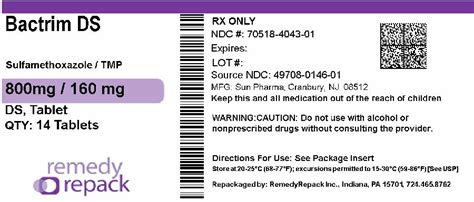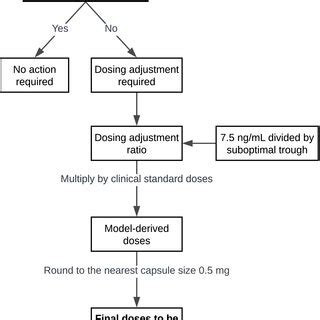Intro
Discover the Bactrim DS dosage guide, including dosage instructions, side effects, and warnings for treating bacterial infections, UTIs, and more, with expert advice on sulfamethoxazole and trimethoprim usage.
The importance of understanding medication dosages cannot be overstated, especially when it comes to antibiotics like Bactrim DS. This medication, a combination of sulfamethoxazole and trimethoprim, is widely used to treat various bacterial infections. However, its effectiveness and safety depend heavily on the correct dosage. Incorrect dosing can lead to reduced efficacy, increased risk of side effects, or even the development of antibiotic-resistant bacteria. Therefore, it's crucial for patients, caregivers, and healthcare professionals to have a comprehensive guide to Bactrim DS dosage.
Understanding the proper use of Bactrim DS begins with recognizing its indications. This antibiotic is prescribed for the treatment of urinary tract infections, acute exacerbations of chronic bronchitis, and other infections caused by susceptible strains of bacteria. The dosage of Bactrim DS is tailored to the specific condition being treated, the severity of the infection, and the patient's renal function, among other factors. This personalized approach ensures that the medication is used effectively while minimizing potential side effects.
The complexity of antibiotic dosing, including that of Bactrim DS, necessitates a thorough review of the medication's pharmacokinetics, the patient's health status, and potential drug interactions. For instance, renal impairment can significantly affect the dosage of Bactrim DS, as both sulfamethoxazole and trimethoprim are excreted by the kidneys. Patients with reduced renal function may require adjusted doses to avoid accumulation of the drug and its metabolites, which can increase the risk of adverse effects. This highlights the importance of careful consideration and monitoring in the administration of Bactrim DS, especially in vulnerable populations such as the elderly or those with pre-existing kidney disease.
Bactrim DS Overview

Bactrim DS is a fixed-dose combination of sulfamethoxazole and trimethoprim, with the "DS" denoting double strength. Each Bactrim DS tablet contains 800 mg of sulfamethoxazole and 160 mg of trimethoprim. The standard adult dosage for urinary tract infections is one Bactrim DS tablet every 12 hours for 10 to 14 days. However, the duration of treatment can vary depending on the severity of the infection and the patient's response to therapy. For acute exacerbations of chronic bronchitis, the typical dosage is one Bactrim DS tablet every 12 hours for 14 days.
Key Considerations for Dosage
The dosage of Bactrim DS must be adjusted in patients with impaired renal function to prevent drug accumulation and potential toxicity. The creatinine clearance (CrCl) is used as a measure of renal function, with adjustments made as follows: for CrCl of 15-30 mL/min, the dosage is reduced by 50%. For patients with a CrCl below 15 mL/min, Bactrim DS is generally not recommended unless the benefits outweigh the risks, in which case the dosage should be reduced and the patient closely monitored.Dosage Adjustments

Dosage adjustments are crucial for ensuring the safe and effective use of Bactrim DS. In addition to renal function, other factors such as age, weight (particularly in pediatric patients), and the presence of other medical conditions can influence the dosage. For instance, elderly patients may require lower doses due to decreased renal function and the potential for increased sensitivity to the drug. In pediatric patients, the dosage is calculated based on the child's weight, typically 8-10 mg/kg/day of trimethoprim, given in two divided doses every 12 hours.
Pediatric Dosage
The pediatric dosage of Bactrim DS is tailored to the child's weight to ensure safety and efficacy. The recommended dosage for children is as follows: - For urinary tract infections and acute otitis media, the dosage is 8-10 mg/kg/day of trimethoprim, given in two divided doses every 12 hours for 10 days. - The maximum recommended dose is one Bactrim DS tablet per 40 pounds of body weight, every 12 hours.Administration and Monitoring

Proper administration and monitoring are key components of Bactrim DS therapy. Patients should be instructed to take the medication with a full glass of water and to complete the full course of treatment, even if symptoms improve before finishing the prescription. Regular monitoring of renal function, particularly in patients with pre-existing kidney disease, is essential to prevent drug toxicity. Additionally, monitoring for signs of adverse effects, such as rash, fever, or gastrointestinal disturbances, can help in the early detection and management of potential complications.
Common Side Effects and Interactions
Like all medications, Bactrim DS can cause side effects and interact with other drugs. Common side effects include nausea, vomiting, diarrhea, and skin rashes. More severe but less common side effects can include Stevens-Johnson syndrome, toxic epidermal necrolysis, and blood dyscrasias. Drug interactions can also occur, particularly with medications that affect renal function or increase the risk of hyperkalemia, such as ACE inhibitors and potassium-sparing diuretics.Special Considerations

Special considerations are necessary for certain patient populations, including pregnant women, nursing mothers, and individuals with specific medical conditions. Bactrim DS is classified as a category C drug in pregnancy, meaning that it should be used only if the potential benefits justify the potential risks to the fetus. In nursing mothers, Bactrim DS is excreted in breast milk, and caution should be exercised when administering this drug to a breastfeeding woman.
Patient Education
Patient education plays a vital role in the safe and effective use of Bactrim DS. Patients should be informed about the importance of completing the full course of treatment, potential side effects, and the need for regular monitoring. They should also be advised to report any signs of adverse reactions promptly and to seek medical attention if they experience severe or unusual symptoms.Conclusion and Future Directions

In conclusion, the dosage of Bactrim DS is a critical aspect of its use in treating bacterial infections. By understanding the factors that influence dosage, including renal function, age, and weight, healthcare providers can optimize treatment outcomes while minimizing the risk of adverse effects. As antibiotic resistance continues to be a global health concern, the appropriate use of antibiotics like Bactrim DS is essential for preserving their effectiveness for future generations.
Final Thoughts
As we move forward in the era of antibiotic resistance, it's essential to approach the use of antibiotics with a thoughtful and informed mindset. This includes not only the selection of the appropriate antibiotic but also the careful consideration of dosage and potential side effects. By doing so, we can ensure that medications like Bactrim DS remain valuable tools in the fight against bacterial infections.What is the standard adult dosage of Bactrim DS for urinary tract infections?
+The standard adult dosage for urinary tract infections is one Bactrim DS tablet every 12 hours for 10 to 14 days.
How should the dosage of Bactrim DS be adjusted in patients with impaired renal function?
+The dosage should be reduced by 50% for patients with a creatinine clearance of 15-30 mL/min. For patients with a creatinine clearance below 15 mL/min, Bactrim DS is generally not recommended unless the benefits outweigh the risks.
What is the recommended pediatric dosage of Bactrim DS for urinary tract infections?
+The recommended dosage for children is 8-10 mg/kg/day of trimethoprim, given in two divided doses every 12 hours for 10 days.
We invite you to share your thoughts and questions about Bactrim DS dosage and its applications in the comments below. Your engagement and feedback are invaluable in helping us provide the most accurate and helpful information possible. Please feel free to share this article with anyone who might find it useful and consider subscribing to our newsletter for more in-depth guides and updates on medical topics.
